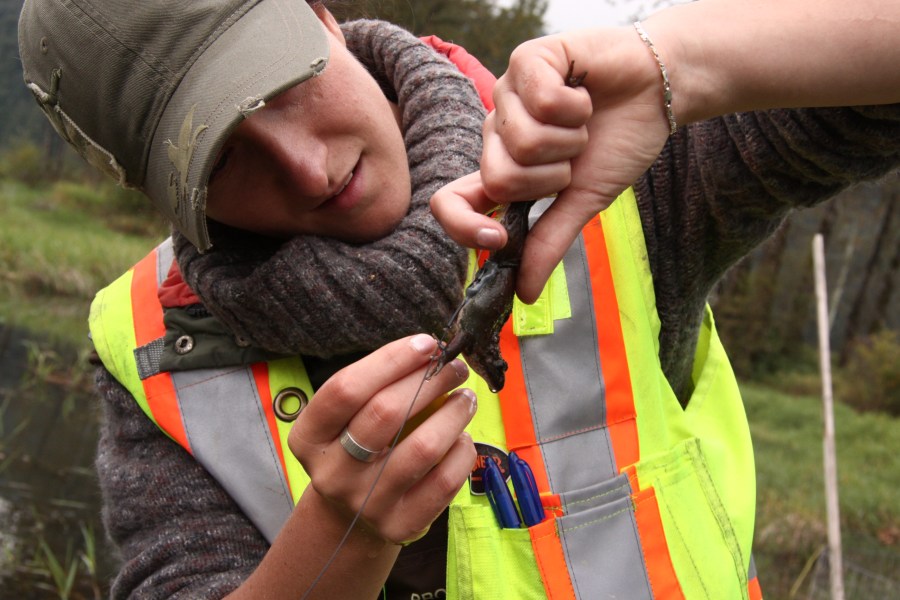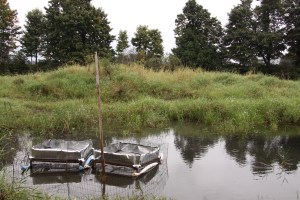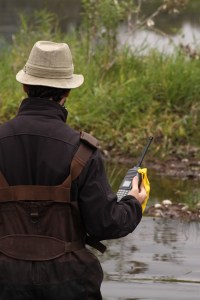Ever wonder what happened to Natashia Cox? For those of you who never met her, Natashia was a participant in the 2010 Kamloops Wetlands Institute and later came to intern with me in the Wetlands Education Program in the winter and spring of 2010/2011. After her term came up, she went off to share her bold enthusiasm for wetlands with others out in the field.
Since mid-May, Natashia’s hard work and fun-loving nature have been missed. That’s why I jumped at the opportunity to take a look at what she’d been doing this summer when she invited me out for a day of radio-telemetry work. Heading out with chest-waders and a big canoe, my partner Eryne and I got a tour of the Chaplin wetland on Seabird Island outside of Agassiz BC. More importantly, I got the chance to learn how telemetry work is done and why it is an important research tool in understanding how some red-listed and invasive species are moving about and using local wetlands.
First, Natashia took us to a few enclosures where juvenile Oregon-spotted frogs were housed before maturity and release into the wetland. These frogs are red-listed: in fact, there are only 3 populations existing in BC. It is important that information on their behavior and habitat requirements are understood so that they can be protected. This is why mature frogs have been fitted with small belts and radio transmitters. While they look quite strange on the frog, Natashia and others who have been working on this project for researcher Monica Pearson take great care to ensure that they are not experiencing discomfort. Each frog is numbered with a corresponding frequency and tracked with a radio receiver. In this way, information on where they move about and what types of conditions they prefer can be determined.
On this excursion Eryne and I had the opportunity to try our hands at tracking frogs with the use of a receiver: it wasn’t easy! Natashia has a real knack for finding these frogs, and she was able to pull a few from the mud for us to weigh, measure and inspect. We also learned how to identify the area where they were found by looking at percentage of canopy cover, for example, or at the conditions of soil or gravel below. As the weather is now cooling, we found that many of these frogs are preparing to burrow down into the muck and hibernate.
Another aspect of the research that she has been assisting with is the tracking of Bullfrogs in a nearby wetland. These invasive amphibians can consume our species of concern, including the Oregon-Spotted and the Red-legged frogs. In fact, Natashia told us stories of how they once tracked a Oregon-Spotted only to find it in the belly of a Bullfrog!
We congratulate Natashia on the great work she continues to do with wetlands in the Fraser Valley. She is now starting a position with the Fraser Valley Watershed Coalition whom I hope to partner with in the near future.
For more information on what is being done in this research, take a look at the Fraser Valley Watershed Coalition’s Frog Blog. Our fun photos from our day of Frog hunting are also linked here. The Bogblog Interview #003 features Natashia and her work below.



Wow, thank you for your kind words.
Great work, Natasha…looks like fun. Neil, where was your canoe???
Natasha, it is great to see you doing such interesting and important work. How long do you leave the transmitters on the frogs?
Each frog is fitted with a transmitter that is proportionate to their body size (usually no greater that 5% of their body mass). Pending on the type of transmitter (Temperature sensitive or just a Pulse), and the overall size- limited by the internal battery that can fit into it, determines how long the belt can stay on. While I was conducting the telemetry, we had some oregon spotted frogs with transmitter belts that lasted a few weeks to a few months. The Bullfrogs that we had belted could last half a year.After a belt expires, we re-belt the frog with a new transmitter (almost always where we found the frog in the wetland),re-release the frog and continue tracking the frog all over the again.